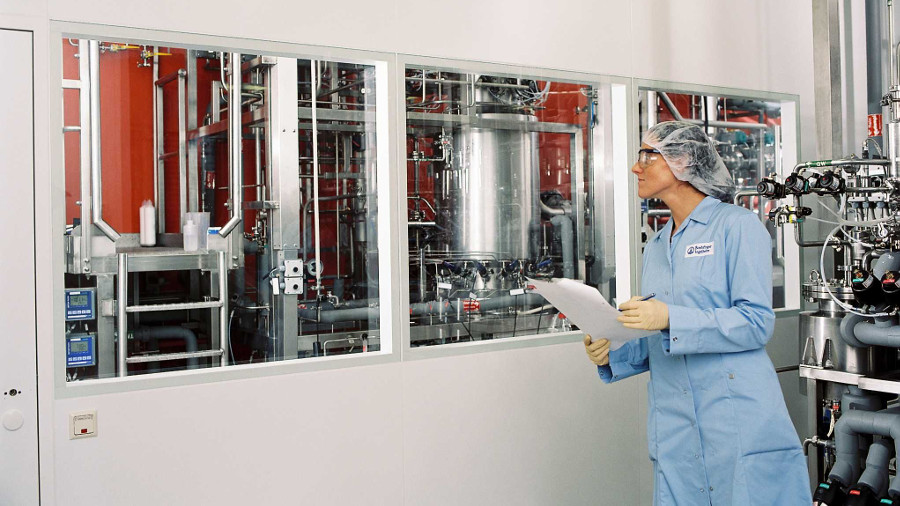
Preparing for the next generation of biologics
Biomanufacturing?While the FDA and EMA have for the first time okayed the switch from batch to continuous manufacture of a pill - Janssen Cilag's HIV protease inhibitor darunavir (Prezista) - the
industry is still waiting for such a signal in the biologics field. The FDA wants to boost adoption, and biopharma majors, such as Novartis, Amgen and Biogen, launched a pilot project to lay the groundwork for the next generation of production: continous USP and DSP, and alternatives to CHO cells.
While Biogen claims its 4 x 18,500L fed-batch biologics manufacturing plant – set to take up operations by 2019 in Luterbach, Switzerland – is next generation, Basel-based pharma major Novartis will be completing a 10-year collaboration with MIT to establish a Novartis-MIT Center for Continuous Manufacturing only a bit later. US and EU regulators have sent out strong signals supporting the shift from fed-batch to continous processes. Apparently, regulators are convinced it would allow more consistent process control and simpler application of process analytical technology, resulting in more reproducible product quality.
Switch to new processes and production systems
Suppliers, such as Pall and Lewa Process Technology, have taken up the idea and most recently launched systems for continous chromatography expected to overcome the bottleneck in downstream processing capacity the industry has suffered in the past decades of growing yields from mammalian cell-based biomanufacturing. The move could energise the market for bioprocessing equipment, which suffered from a drop to mid-one-digit-per cent growth in H1/2017 compared to double digit expansion in previous years. Projections from Bioplan Associates’ 14th Annual Industry Survey, however, point to the optimism of suppliers that could translate into investment, says Eric Langer, the company’s president.
Feeling the cost pressure from drug developers, cell line developers and CDMOs are seeking to further improve productivity of CHO cells, the industry’s working horse for biologics manufacturing, a market that has grown to more than US$70bn in annual sales. In August, Horizon Discovery published the complete annotated DNA sequence of its CHO-K1 cell line in hopes of driving cell line innovation. While 81% of biologics manufactured today stem from mammalian cell culture, companies such as Biogen and Dyadic International are already testing alternatives. This April, Biogen’s VP of International Manufacturing Operations, Eliana Clark, said CHO cells wouldn’t be Biogen’s first choice for cheap production of biologics in the future. Dyadic International, which produces yeast strains, wants to make its C1 expression platform as effective for biologics production as it is for biofuels manufacture, where it yields up to 80g/l.
Clark said that Biogen co-funds a project with the Bill & Melinda Gates Foundation and the MIT Center for Biomedical Innovation (led by Biogen’s Head of QbD, Rohin Mhatre) that would allow a departure from the safe but costly production in CHO cells. In an 18-month effort, researchers at MIT and Biogen have engineered eight alternative hosts for the production of human antibodies, including fungal (such as yeast and chytrids), algae (diatom) and trypanosome (leishmanial) systems to produce full-length mAbs. Results of the systematic comparison will be presented in Q3/2017. Mark Emalfarb, CEO of Dyadic International predicts that limitations of CHO cells in the production of modern, engineered antibody formats will convince producers to select more effective production systems.
Serialisation: 50% of CMOs not prepared
Full CDMO service providers such as Polpharma (see p. 64) told European Biotechnology that they have just begun to test alternative cell lines besides its proprietary mammalian cell lines and bacterial expression systems for biologics and biosimilar production. According to Markets & Markets, the Global Healthcare Track and Trace Solutions Market is projected to reach US-$2.81bn by 2021, at a CAGR of 17.3% from 2016 to 2021. However, deadlines for including unique product identifiers on prescription drugs are putting a strain on biopharma companies and CMOs, many of which are ill-prepared to meet the targets. Accordingly, the US Food and Drug Administration (FDA) extended the deadline this summer for the US Drug Supply Chain Security Act (DSCSA) to November 2018. European companies, however, won’t be able to sell any prescription drugs after 9 February, 2019, unless they meet the serialization requirements set out by EU regulators. In September, serialization solutions company Adents passed the certification test at the European Medicines Verification Organization (EMVO) for connection to the European Hub. Five hundred days before the EU’s falsified medicines rules will get into application, many companies are far away from uploading their serialisation data through the gateway provider. According to supply chain services provider Tracelink, as many as 400 contract manufacturing organisations (CMOs) will not be ready for upcoming US and EU track-and-trace regulations.
CROs: Brexit to impact 1,000 companies
Globally, companies in the contract research market face strong headwinds. Following criticism from Big Pharma about the pricing of CRO services, analysts expected a downturn in bookings. However, as bookings from small and mid-sized biotechs increased in Q2/2017, big shots in the CRO segment, such as INC, seemed to sidestep critics from larger firms by increasingly focussing on small biopharma clients. In fact, SMEs contributed to 47% of INC’s sales in H1/2017 vs 41% as of H1/2016. The big CROs’ interest in SME customers puts pressure on mid-sized CROs, which have traditionally made a good deal (70-80%) of their revenues) in the SME segment.
In Europe, Brexit puts pressure on UK-based companies. While the UK government announced in September it wants to increase the number of clinical trials by 50%, the expected move of the EMA from London to (most probably) Amsterdam shows that it is totally unclear what will happen after the nation’s EU exit in 2019 to CROs located in the UK. According to the CEO of IAOCR, Jacqueline Johnson North, Brexit will have a big impact on about 990 entities related to the contract research sector, which mostly believe that Brexit will have a negative impact on the UK’s CROs. According to EU rules, non-EU drug manufacturers will need to import their drugs and cannot participate in the EU’s centralised procedure for market authorisation which applies to all biological medicines. After UK’s pharma major GlaxoSmithKline announced it will turn away its investments from its home base, the UK government published a position paper calling on it to maintain close ties with the EU’s Horizon2020 programme and the EMA.
Real world data integration
Another long-term challenge for CROs may come from their clients’ interest in collecting real-world evidence for assessing the safety and efficacy of drug candidates (see p. 16). This would bring speed into the system,
Roche Pharma AG’s Head, Hagen Pfundner, told European Biotechnology.
Real-world evidence could become relevant in drug development very rapidly. In-mid September, FDA Commissioner Scott Gottlieb stressed the development costs of pharmaceuticals had become unsustainable and announced that the FDA will modernize the collection of clinical data through adaptive or seamless trials, which would go from first-in-man testing through approval in a single continuous trial. Previously, CDER director Janet Woodcock and colleagues had reinforced the FDA’s stance on the incorporation of real-world evidence into clinical trials. According to Woodcock, clinical trials and real-world evidence are complementary and studying electronic medical records (EMRs) can be cheaper than RCTs and help answer questions regarding individual dosing and long-term outcomes and side effects. In June, EMR specialist Flatiron Health announced upcoming collaborations with the FDA and the National Cancer Institute (NCI) to explore how real-world evidence derived from de-identified patient data captured at the point of care can be used for clinical trial design and prospective research studies. The collaboration will explore how real-world evidence derived from Flatiron’s melanoma and non-small cell lung cancer datasets can be used to improve study planning, inform sample size calculations, ease study implementation, better understand current trends in standard of care, and address specific study planning questions.
Cheaper than expected
Overall, biopharma companies are apparently searching for partners to help them adapt to increasing costs in order to meet shareholder expectations. A new estimate on the average development cost of cancer meds, published 9/11 in JAMA (doi: 10.1001(jamainternmed.2017.3601), however, could become a earthquake to the sector. Sham Mailankody from Sloan Kettering Cancer Center estimated the median development cost of 10 single cancer meds at US$648m each, while median revenues of every drug almost hit US$6.7.bn
(First published in European Biotechnology, Autumn Edition 2017)


 Pharmahungary Group
Pharmahungary Group Sofinnova Partners
Sofinnova Partners VFA
VFA